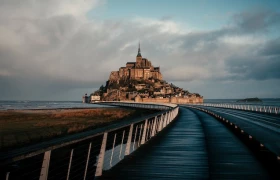Les 12 choses incontournables à faire en Normandie
Dernière mise à jour : 26/05/2024 15:38Sommaire
- A visiter
-
- 1 - Découvrez le Mont Saint-Michel
- 2 - Découvrez les Plages du Débarquement
- 3 - Promenez-vous à Honfleur
- 4 - Les falaises d'Étretat
- 5 - Flânez dans les jardins de Giverny
- 6 - Les abbayes aux Dames et aux Hommes
- 7 - Château de Caen
- 8 - Bayeux
- 9 - Château de Falaise
- 10 - La tapisserie de Bayeux
- 11 - Découvrez le Château de Fontaine-Henry
- 12 - Parcourez la ville de Rouen
- La Normandie - Où Loger ?
- La Normandie - Comment se déplacer ?
- La Normandie - Meilleure période
Explorez les plages historiques du Débarquement et plongez dans l'histoire de la Seconde Guerre mondiale. Découvrez le charme médiéval du Mont-Saint-Michel, avec ses ruelles pavées et son abbaye majestueuse. Rouen, ville d'art et d'histoire, séduit avec sa cathédrale et ses quartiers pittoresques. Honfleur offre un port romantique entouré de maisons à colombages. Les falaises d'Étretat offrent des panoramas spectaculaires sur la mer.
Explorez les châteaux normands, témoins de l'histoire féodale. Goûtez au cidre et aux fromages locaux dans les cidreries et fromageries. Les jardins de Giverny, source d'inspiration de Monet, captivent les amateurs d'art.
Le Parc Naturel Régional des Boucles de la Seine propose des activités en plein air. Assistez à des festivals, des foires et des événements culturels tout au long de l'année. Plongez dans la gastronomie normande entre produits de la mer, cidre et fromages renommés. Explorez une région riche en diversité, mêlant patrimoine, nature préservée et saveurs authentiques.
1 - Découvrez le Mont Saint-Michel
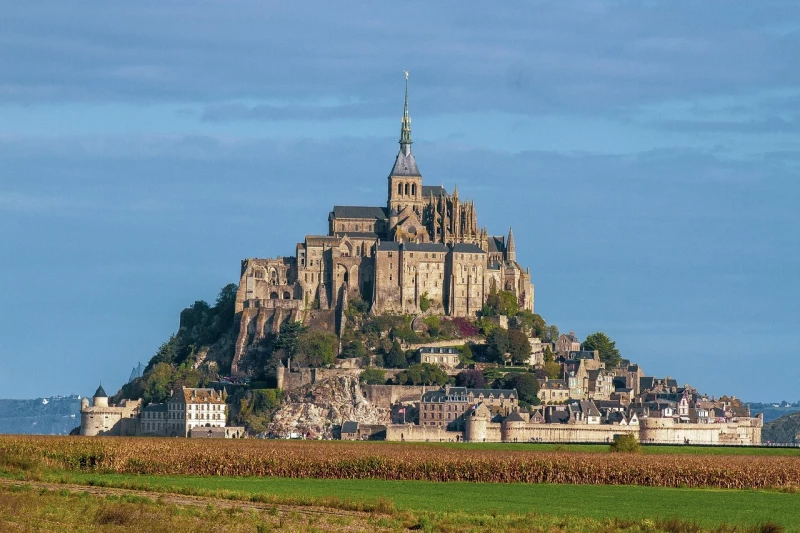
Mont Saint-Michel, situé en Normandie, est une île commune exceptionnelle. Au cœur de cette merveille architecturale se dresse l'abbaye médiévale, témoignage du génie gothique. Entouré par les marées, l'accès à l'île varie, offrant des panoramas uniques. Le village pittoresque au pied de l'abbaye présente des ruelles pavées, des boutiques et des restaurants charmants.
L'abbaye du Mont Saint-Michel, fondée au VIIIe siècle, a joué un rôle important dans l'histoire, évoluant entre lieu de pèlerinage et forteresse stratégique. L'architecture combine éléments religieux et militaires. Les vues du Mont Saint-Michel depuis la baie sont à couper le souffle, surtout quand l'île est illuminée la nuit.
Accessible en voiture ou par navette, il est essentiel de vérifier les horaires des marées. Outre l'abbaye, le Mont Saint-Michel propose musées, restaurants et boutiques. Classé au patrimoine mondial de l'UNESCO, il attire des millions de visiteurs pour son histoire, son architecture et son ambiance unique. Une visite de cette île emblématique offre une plongée dans le passé médiéval, combinée à des vues spectaculaires et une atmosphère magique.
En Savoir Plus  Nos astuces pour tirer le meilleur parti de votre expérience.
Nos astuces pour tirer le meilleur parti de votre expérience.
Visiter le Mont Saint-Michel peut être une expérience inoubliable. Voici quelques astuces pour rendre votre visite encore plus agréable :
-
Consultez les horaires des marées : Les marées influent sur l'accès à l'île. Consultez les horaires des marées et planifiez votre visite pendant la marée basse pour profiter de l'accès à pied ou lors de la marée haute pour observer le Mont Saint-Michel entouré d'eau.
-
Évitez les périodes de forte affluence : Le Mont Saint-Michel peut être très fréquenté, surtout pendant les vacances scolaires et les week-ends. Pour éviter les foules, envisagez de visiter en semaine ou hors saison.
-
Arrivez tôt ou en fin de journée : Pour une expérience plus paisible, arrivez tôt le matin ou en fin de journée. Vous pourrez ainsi profiter de la beauté du site avec moins de visiteurs.
-
Réservez vos billets en ligne : Économisez du temps en réservant vos billets en ligne. Cela peut également vous permettre de bénéficier de créneaux horaires spécifiques et d'éviter les files d'attente.
-
Préparez-vous à marcher : L'île est principalement piétonne, avec des ruelles pavées et des escaliers. Portez des chaussures confortables et soyez prêt à marcher.
-
Explorez le village : Ne vous limitez pas à l'abbaye. Explorez les ruelles du village, découvrez les boutiques artisanales et goûtez aux spécialités locales.
-
Profitez des points de vue : Montez jusqu'à l'abbaye pour des vues panoramiques, mais n'oubliez pas les autres points de vue, comme la promenade le long des remparts.
-
Préparez votre appareil photo : Le Mont Saint-Michel offre des opportunités photographiques exceptionnelles. Assurez-vous d'avoir suffisamment de batterie et d'espace sur votre carte mémoire.
-
Visitez les musées : Les musées sur l'île offrent des informations supplémentaires sur l'histoire du Mont Saint-Michel. Prenez le temps de les explorer.
-
Dégustez la cuisine locale : Les restaurants locaux proposent des plats délicieux. Essayez les spécialités normandes, comme l'agneau de pré-salé et les galettes.
-
Soyez conscient de la météo : La météo en Normandie peut être changeante. Apportez des vêtements appropriés, surtout si vous prévoyez de passer du temps à l'extérieur.
-
Respectez l'environnement : Le Mont Saint-Michel est un site naturel et historique. Respectez les règles, ne laissez pas de déchets, et appréciez le site de manière responsable.
En suivant ces astuces, vous maximiserez votre expérience de visite au Mont Saint-Michel. Profitez de chaque instant dans ce lieu exceptionnel.
2 - Découvrez les Plages du Débarquement
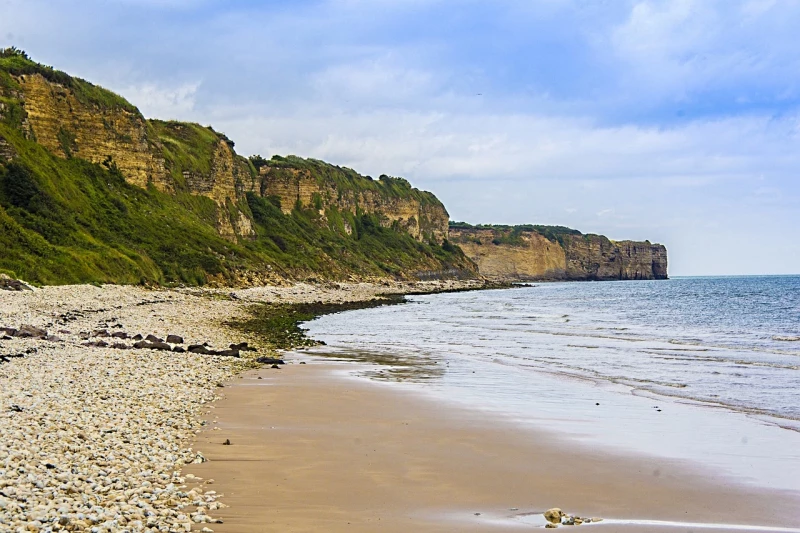
Explorez l'émouvante histoire des Plages du Débarquement en Normandie lors d'un voyage fascinant. Parcourez les légendaires Utah Beach et Omaha Beach, témoins des débarquements alliés pendant la Seconde Guerre mondiale. Visitez la Pointe du Hoc, où l'audace des Rangers américains s'est déployée sur des falaises stratégiques. Le Musée du Débarquement à Arromanches retrace l'ingéniosité du port artificiel Mulberry. À Sainte-Mère-Église, le Musée Airborne honore les parachutistes. Les cimetières de Colleville-sur-Mer et Bayeux rappellent le sacrifice des soldats.
Suivez l'itinéraire du Débarquement à travers des villes et villages clés. Participez aux événements commémoratifs, comme les cérémonies du 6 juin, pour une expérience immersive. Choisissez un hébergement proche pour une immersion totale. Savourez la cuisine normande, avec ses délices locaux. Engagez un guide local pour des récits authentiques. Respectez la solennité des lieux et prenez le temps de vous recueillir. Ce voyage vous plongera dans le passé, offrant une compréhension approfondie et respectueuse des sacrifices consentis lors de cette période cruciale de l'histoire mondiale.
 Nos astuces pour tirer le meilleur parti de votre expérience.
Nos astuces pour tirer le meilleur parti de votre expérience.
Visiter les Plages du Débarquement en Normandie peut être une expérience riche et émouvante. Voici quelques astuces pour maximiser votre visite :
-
Planification : Préparez votre itinéraire à l'avance en identifiant les plages et les sites que vous souhaitez visiter. Assurez-vous de vérifier les horaires d'ouverture des musées et des monuments.
-
Guides locaux : Engagez un guide local pour bénéficier d'informations approfondies, d'anecdotes historiques et d'une perspective locale.
-
Musées : Visitez les musées dédiés au Débarquement, tels que le Musée du Débarquement à Arromanches et le Musée Airborne à Sainte-Mère-Église, pour une compréhension approfondie de l'histoire.
-
Cérémonies commémoratives : Consultez le calendrier des événements commémoratifs et assistez à des cérémonies pour une expérience plus authentique.
-
Location de véhicule : Pour plus de flexibilité, envisagez de louer une voiture pour explorer la région à votre propre rythme.
-
Hébergement : Choisissez un hébergement à proximité des Plages du Débarquement pour maximiser votre temps sur place.
-
Respect des lieux : Soyez respectueux en visitant les cimetières et les monuments. Gardez à l'esprit la solennité des lieux et évitez de perturber la tranquillité.
-
Itinéraire du Débarquement : Suivez l'itinéraire officiel du Débarquement qui relie les principaux sites. Des panneaux d'information sont généralement disponibles le long du chemin.
-
Application mobile : Utilisez des applications mobiles dédiées au Débarquement pour obtenir des informations en temps réel et des commentaires audio pendant votre visite.
-
Période de visite : Évitez les périodes de vacances scolaires si possible, pour profiter de sites moins fréquentés.
-
Tenue confortable : Prévoyez des chaussures confortables, car vous pourriez marcher beaucoup, en particulier si vous explorez des zones comme la Pointe du Hoc.
-
Photographies : Capturez vos moments, mais soyez conscient du caractère sensible des lieux.
En suivant ces astuces, vous pourrez tirer le meilleur parti de votre visite aux Plages du Débarquement, en honorant l'histoire et en appréciant la signification de ces sites emblématiques.
3 - Promenez-vous à Honfleur
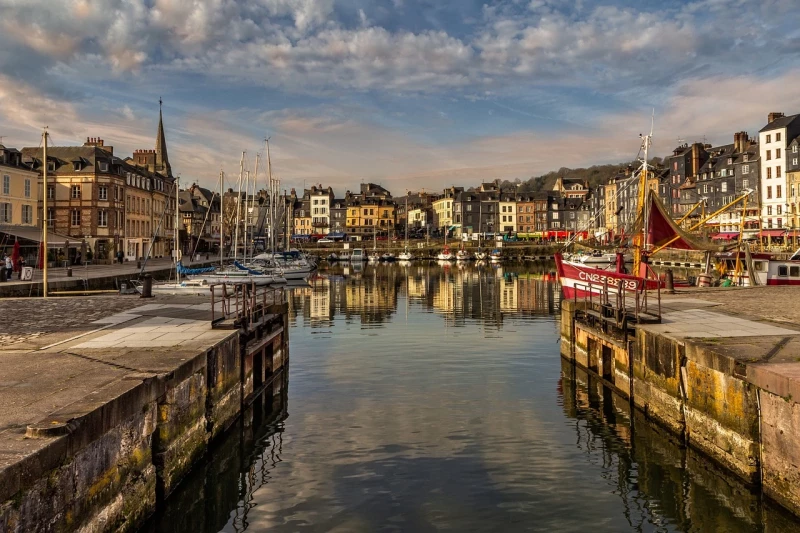
Se promener à Honfleur est une expérience charmante, cette ville portuaire pittoresque en Normandie est réputée pour ses ruelles pavées, ses maisons à colombages et son Vieux Bassin. Voici quelques suggestions pour une promenade agréable à Honfleur :
-
Vieux Bassin : Commencez votre promenade au célèbre Vieux Bassin. Admirez les bateaux colorés amarrés et les maisons pittoresques qui entourent ce port emblématique.
-
Quai Sainte-Catherine : Suivez le Quai Sainte-Catherine le long du bassin. Vous y découvrirez des galeries d'art, des boutiques et des cafés avec des terrasses offrant une vue magnifique sur le port.
-
Église Sainte-Catherine : Visitez l'église Sainte-Catherine, une église en bois remarquable qui a été construite par les marins eux-mêmes.
-
Les Greniers à Sel : Explorez les Greniers à Sel, un lieu historique qui servait autrefois à stocker le sel. Il accueille maintenant des expositions culturelles.
-
Rue du Dauphin et Place Sainte-Catherine : Parcourez la charmante Rue du Dauphin et arrivez à la Place Sainte-Catherine. Vous y trouverez des cafés en plein air et une atmosphère détendue.
-
Le Jardin des Personnalités : Faites un détour par le Jardin des Personnalités, où des bustes célèbrent des personnalités liées à Honfleur, notamment le peintre Eugène Boudin.
-
Maisons à colombages : Perdez-vous dans les ruelles étroites bordées de maisons à colombages. Chaque coin révèle une nouvelle perspective pittoresque.
-
Plage du Butin : Si le temps le permet, faites une pause à la Plage du Butin pour profiter du panorama sur l'estuaire de la Seine.
-
Les Arts en Balade : Consultez les galeries d'art locales le long de votre promenade. Honfleur a longtemps été une source d'inspiration pour de nombreux artistes.
-
Port de Plaisance : Terminez votre promenade en explorant le Port de Plaisance, où vous pouvez observer la vie maritime locale.
Honfleur offre une expérience pittoresque, imprégnée d'histoire et de charme. Prenez votre temps pour apprécier l'ambiance unique de cette ville portuaire normande.
 Nos astuces pour tirer le meilleur parti de votre expérience.
Nos astuces pour tirer le meilleur parti de votre expérience.
Visiter Honfleur est une expérience plaisante et enrichissante. Voici quelques astuces pour tirer le meilleur parti de votre visite dans cette charmante ville normande :
-
Horaire de Visite : Honfleur est souvent plus calme le matin et en début de soirée. Profitez de ces moments pour explorer la ville sans les foules.
-
Parking : Si vous arrivez en voiture, utilisez le parking public proche du Vieux Bassin. Assurez-vous de connaître les horaires et tarifs de stationnement.
-
Balade Matinale : Commencez votre journée par une promenade matinale autour du Vieux Bassin lorsque la ville s'éveille.
-
Vieux Bassin en Soirée : Revenez au Vieux Bassin en soirée pour profiter de l'ambiance romantique avec les lumières des restaurants et des boutiques.
-
Musées et Galeries : Explorez les musées et galeries d'art, comme le Musée Eugène Boudin, pour découvrir l'histoire artistique de la région.
-
Gastronomie : Goûtez aux spécialités locales dans les restaurants du Vieux Bassin ou de la Rue Sainte-Catherine. Les fruits de mer sont particulièrement réputés.
-
Coucher de Soleil à la Plage : Assistez au coucher de soleil depuis la Plage du Butin pour une vue magnifique sur l'estuaire de la Seine.
-
Promenade le Long du Quai Sainte-Catherine : Explorez le Quai Sainte-Catherine et découvrez ses boutiques et cafés pittoresques.
-
Église Sainte-Catherine : Ne manquez pas de visiter l'église Sainte-Catherine, une structure en bois unique en son genre.
-
Shopping Local : Parcourez les boutiques locales pour des souvenirs uniques, notamment des produits artisanaux et des œuvres d'artistes locaux.
-
Événements Locaux : Vérifiez s'il y a des événements spéciaux ou des festivals locaux pendant votre séjour.
-
Croisière sur la Seine : Optez pour une courte croisière sur la Seine pour une perspective différente de la ville depuis l'eau.
-
Visite Nocturne : Honfleur prend une toute autre dimension la nuit. Explorez les ruelles éclairées pour une expérience atmosphérique.
-
Application Mobile : Utilisez des applications touristiques ou guides pour obtenir des informations en temps réel pendant votre visite.
-
Respect des Sites : Soyez respectueux envers les sites historiques et religieux, et profitez de l'atmosphère détendue de cette belle ville portuaire.
En suivant ces astuces, votre visite à Honfleur sera non seulement agréable mais aussi mémorable. Profitez de chaque instant dans cette ville pittoresque.
4 - Les falaises d'Étretat
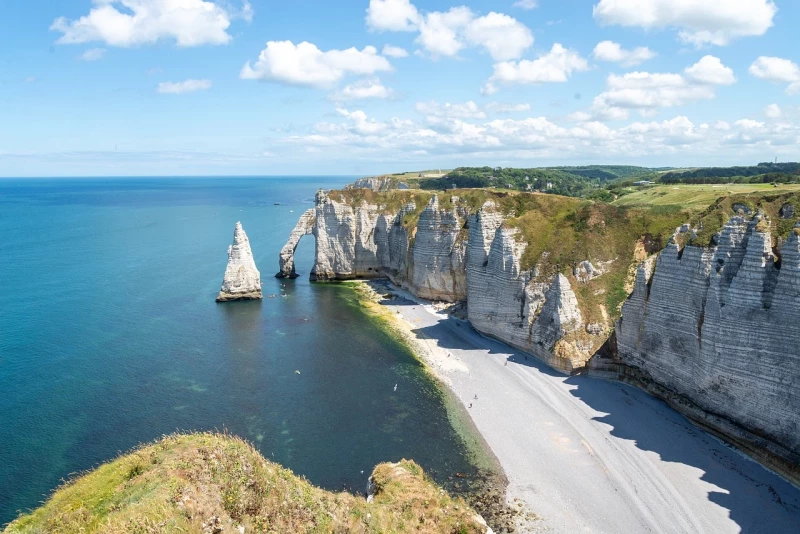
Les falaises d'Étretat, joyau naturel de la Normandie, offrent une expérience de voyage à couper le souffle. Ces formations rocheuses imposantes, façonnées par le temps et les éléments, évoquent un sentiment de grandeur et de mystère. Lorsque l'on gravit les sommets, le panorama s'ouvre sur la Manche, offrant des vues époustouflantes sur les eaux tumultueuses et les falaises ciselées. La plage d'Étretat, bordée de galets, offre un autre point de vue saisissant sur ces géants de pierre, créant une toile de fond unique. Les Jardins d'Étretat, avec leurs sculptures et leurs aménagements paysagers, complètent harmonieusement la nature brute des falaises.
Chaque arche, chaque aiguille raconte une histoire, l'Arche de la Porte d'Aval se dressant majestueuse et l'Aiguille Creuse évoquant des récits littéraires. Les sentiers côtiers serpentent le long des falaises, révélant des perspectives changeantes et invitant à des promenades contemplatives. Les couchers de soleil magiques teintent les falaises d'une lumière dorée, créant une atmosphère enchanteresse. Les activités nautiques sur la mer ajoutent une dimension aventureuse à cette escapade, offrant une perspective unique depuis les eaux.
Étretat a inspiré des artistes et écrivains pendant des siècles, créant une connexion profonde entre la nature et la créativité humaine. En dégustant la cuisine normande dans les cafés en bord de mer et en participant à des événements culturels locaux, on découvre une immersion totale dans cette destination unique. Respecter l'environnement préservé de ce site exceptionnel devient une responsabilité et une contribution à la préservation de sa beauté naturelle pour les générations futures. Un voyage à Étretat promet une aventure où la nature, l'histoire et l'art se rencontrent dans un paysage exceptionnel.
 Nos astuces pour tirer le meilleur parti de votre expérience.
Nos astuces pour tirer le meilleur parti de votre expérience.
Visiter les falaises d'Étretat est une expérience inoubliable. Voici quelques astuces pour tirer le meilleur parti de votre visite :
-
Horaire de Visite : Planifiez votre visite tôt le matin ou en fin d'après-midi pour éviter les foules et profiter des meilleures conditions de lumière.
-
Chaussures Confortables : Portez des chaussures confortables et antidérapantes, surtout si vous prévoyez de marcher le long des sentiers côtiers ou de gravir les falaises.
-
Point de Vue : Explorez différents points de vue en suivant les sentiers côtiers. Chacun offre une perspective unique sur les falaises et les formations rocheuses.
-
Plage d'Étretat : Descendez jusqu'à la plage pour une vue saisissante des falaises depuis la mer. Soyez conscient des marées si vous prévoyez d'explorer les grottes.
-
Conditions Météorologiques : Vérifiez les conditions météorologiques avant votre visite. Les falaises peuvent avoir une atmosphère différente sous la pluie, mais assurez-vous de prendre des précautions.
-
Photographie : Si vous êtes passionné de photographie, apportez votre appareil pour capturer la beauté spectaculaire des falaises, surtout au lever ou au coucher du soleil.
-
Guide Local : Engagez un guide local pour en apprendre davantage sur l'histoire, la géologie et les anecdotes fascinantes liées à Étretat.
-
Jumelles : Des jumelles peuvent être utiles pour observer les détails des falaises et de la faune marine depuis les points d'observation éloignés.
-
Bouteille d'Eau : Apportez une bouteille d'eau, surtout si vous envisagez de marcher ou de faire de la randonnée autour des falaises.
-
Respect de la Nature : Soyez respectueux de l'environnement. Suivez les sentiers désignés, ne dérangez pas la faune et évitez de laisser des déchets.
-
Vêtements en Couches : En fonction de la saison, prévoyez des vêtements en couches. Les conditions météorologiques peuvent changer rapidement le long de la côte.
-
Informations Locales : Consultez le bureau d'information touristique local pour obtenir des informations mises à jour sur les sentiers, les conditions météorologiques et les événements spéciaux.
En suivant ces astuces, votre visite aux falaises d'Étretat sera non seulement agréable, mais aussi enrichissante et sûre. Profitez de la majesté naturelle de cet endroit emblématique.
5 - Flânez dans les jardins de Giverny
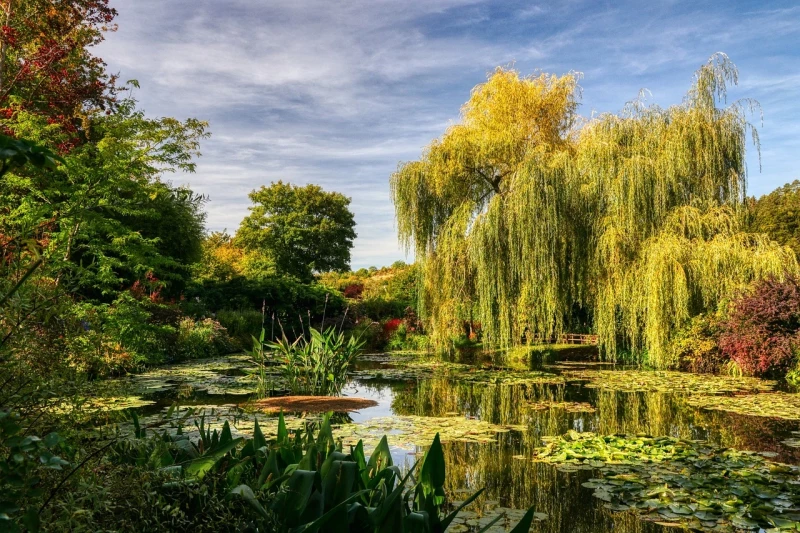
Les Jardins de Giverny, situés à quelques kilomètres de Paris, offrent une escapade enchanteresse dans l'univers floral qui a captivé l'âme du célèbre artiste impressionniste Claude Monet. Le jardin d'eau, avec son pont japonais surplombant des nymphéas, évoque les toiles emblématiques de Monet et crée une atmosphère de contemplation paisible. Le Clos Normand, quant à lui, dévoile des parterres de fleurs vibrantes disposés avec une précision artistique, incarnant la passion de Monet pour la couleur et la composition.
Au printemps, les iris éclatent de couleurs vives, tandis que le jardin de roses exhale un parfum enivrant. La maison de Monet, baignée de lumière, offre un aperçu de la vie quotidienne du peintre et de son atelier où la magie créatrice s'opérait. Chaque saison révèle une nouvelle facette des jardins, soulignant l'éternelle métamorphose de la nature.
Les visiteurs peuvent s'immerger dans l'héritage artistique de Monet tout en déambulant dans ces jardins empreints de poésie. La boutique de souvenirs propose des trésors inspirés par les œuvres du maître, tandis que les guides locaux partagent des anecdotes fascinantes sur l'histoire du lieu. La tranquillité des lieux, associée à la splendeur florale, crée une expérience qui transcende le simple voyage pour devenir une véritable rencontre avec l'esthétique captivante de Giverny. Un périple à travers ces jardins, avec leur harmonie visuelle exceptionnelle, est une célébration de l'art, de la nature et de l'imagination de Claude Monet.
 Nos astuces pour tirer le meilleur parti de votre expérience.
Nos astuces pour tirer le meilleur parti de votre expérience.
Visiter les Jardins de Giverny est une expérience artistique et florale exceptionnelle. Voici quelques astuces pour tirer le meilleur parti de votre visite :
-
Achetez vos Billets à l'Avance : Évitez les files d'attente en achetant vos billets en ligne à l'avance, surtout pendant les périodes de forte affluence.
-
Horaire de Visite : Planifiez votre visite tôt le matin ou en fin d'après-midi pour profiter d'une atmosphère plus paisible et des meilleures conditions de lumière.
-
Saison de Visite : Choisissez la saison qui correspond à vos préférences florales. Chaque saison offre une perspective unique sur les jardins.
-
Guides Locaux : Optez pour une visite guidée avec un guide local pour obtenir des informations approfondies sur l'histoire des jardins et de Claude Monet.
-
Jardin d'Eau en Premier : Commencez par explorer le jardin d'eau avec le pont japonais. C'est l'une des parties les plus emblématiques et photographiées.
-
Horaire de la Maison de Monet : Assurez-vous de connaître les horaires de visite de la maison de Monet, qui est une étape incontournable pour comprendre la vie du peintre.
-
Photographie : Si vous êtes passionné de photographie, apportez votre appareil pour capturer la beauté des fleurs et des paysages.
-
Picnic dans les Jardins : Certains jours, les visiteurs sont autorisés à apporter un picnic. Profitez-en pour savourer un repas au cœur de ces jardins enchanteurs.
-
Temps de Repos : Prévoyez du temps pour vous asseoir, vous détendre et prendre le temps d'apprécier l'atmosphère paisible des lieux.
-
Explorez Tous les Coins : N'hésitez pas à explorer tous les coins des jardins, y compris le Clos Normand et le jardin de roses, pour une expérience complète.
-
Respectez les Plantes : Soyez respectueux envers les plantes et les installations. Évitez de marcher sur les plates-bandes et respectez les indications.
-
Boutique de Souvenirs : Faites un tour à la boutique de souvenirs pour acheter des articles inspirés par les œuvres de Monet et les jardins.
-
Informations sur les Événements : Renseignez-vous sur d'éventuels événements spéciaux, expositions ou manifestations qui pourraient avoir lieu lors de votre visite.
En suivant ces astuces, votre visite aux Jardins de Giverny sera non seulement agréable mais aussi enrichissante, vous permettant de vous immerger pleinement dans la magie florale et artistique de cet endroit emblématique.
6 - Les abbayes aux Dames et aux Hommes
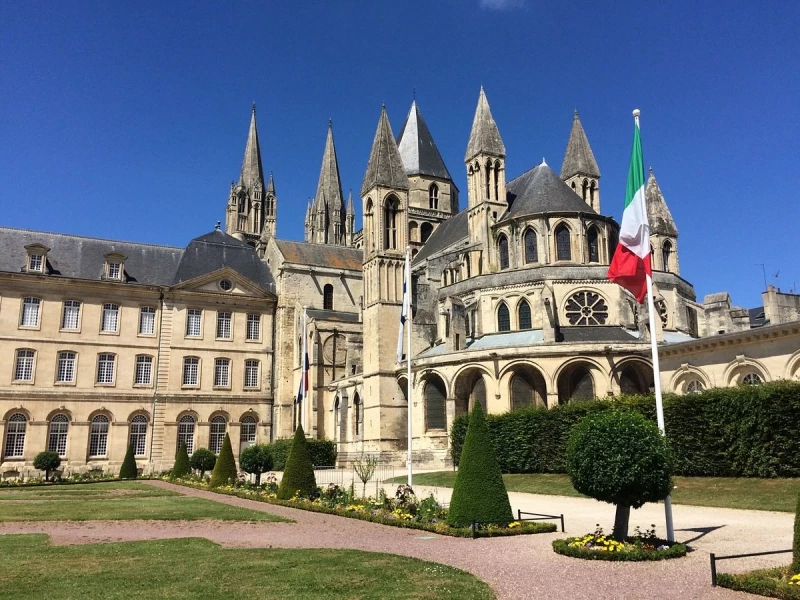
Les abbayes aux Dames et aux Hommes, situées à Caen, Normandie, forment un ensemble architectural emblématique témoignant de l'histoire médiévale.
Fondée au 11e siècle par Mathilde de Flandre, l'Abbaye aux Dames, ou Abbaye Sainte-Trinité, se distingue par son architecture romane remarquable. Son église abbatiale, impressionnante avec sa façade et ses voûtes élégantes, a joué un rôle clé dans l'histoire normande en abritant les sépultures de Mathilde et de Guillaume le Conquérant.
L'Abbaye aux Hommes, ou Abbaye Saint-Étienne, fondée par Guillaume le Conquérant, est un autre exemple impressionnant d'architecture romane normande. Construite en expiation du mariage controversé entre Guillaume et Mathilde, elle est le lieu de repos final du monarque. Aujourd'hui, l'Abbaye aux Dames abrite le Centre Hospitalier Universitaire, tandis que l'Abbaye aux Hommes est devenue l'hôtel de ville de Caen. Ces deux édifices, voisins et liés à l'histoire des souverains normands, captivent par leur architecture majestueuse et leur importance historique, constituant des joyaux du patrimoine médiéval normand.
 Nos astuces pour tirer le meilleur parti de votre expérience.
Nos astuces pour tirer le meilleur parti de votre expérience.
Visiter les abbayes aux Dames et aux Hommes à Caen est une expérience historique captivante. Voici quelques astuces pour tirer le meilleur parti de votre visite :
-
Billets Combinés : Achetez des billets combinés pour les deux abbayes afin de bénéficier d'une expérience complète et économiser sur les coûts.
-
Visite Guidée : Optez pour une visite guidée pour obtenir des informations approfondies sur l'histoire, l'architecture et les personnalités qui ont marqué ces lieux.
-
Horaires d'Ouverture : Vérifiez les horaires d'ouverture des abbayes. Certaines périodes peuvent être plus propices à la tranquillité et à une meilleure exploration.
-
Audio-guides : Si les visites guidées ne sont pas disponibles, envisagez d'utiliser des audio-guides pour bénéficier d'informations détaillées pendant votre exploration.
-
Concerts et Événements : Renseignez-vous sur d'éventuels concerts ou événements spéciaux organisés dans les abbayes. Certains événements permettent une expérience unique dans ces lieux chargés d'histoire.
-
Tenue Appropriée : Portez une tenue respectueuse des lieux sacrés. Les abbayes sont des sites religieux, et une tenue décente est généralement requise.
-
Découverte des Jardins : Prenez le temps d'explorer les jardins entourant les abbayes. Ces espaces offrent souvent une atmosphère paisible et des vues panoramiques.
-
Photographie : Capturez la majesté architecturale des abbayes, mais soyez conscient des règles en matière de photographie, en particulier dans les zones sensibles.
-
Pause Détente : Prévoyez des moments de pause pour vous asseoir et absorber l'atmosphère spirituelle des lieux.
-
Lecture Préalable : Familiarisez-vous avec l'histoire des abbayes avant votre visite. Cela enrichira votre expérience en comprenant mieux les contextes historiques.
-
Respect des Édifices : Soyez respectueux des édifices, des objets sacrés et de l'environnement. Évitez de toucher des éléments anciens et précieux.
-
Boutiques de Souvenirs : Explorez les boutiques de souvenirs pour des articles uniques liés à l'histoire des abbayes.
En suivant ces astuces, votre visite aux abbayes aux Dames et aux Hommes à Caen sera à la fois enrichissante et respectueuse de l'importance historique et culturelle de ces sites religieux remarquables.
7 - Château de Caen
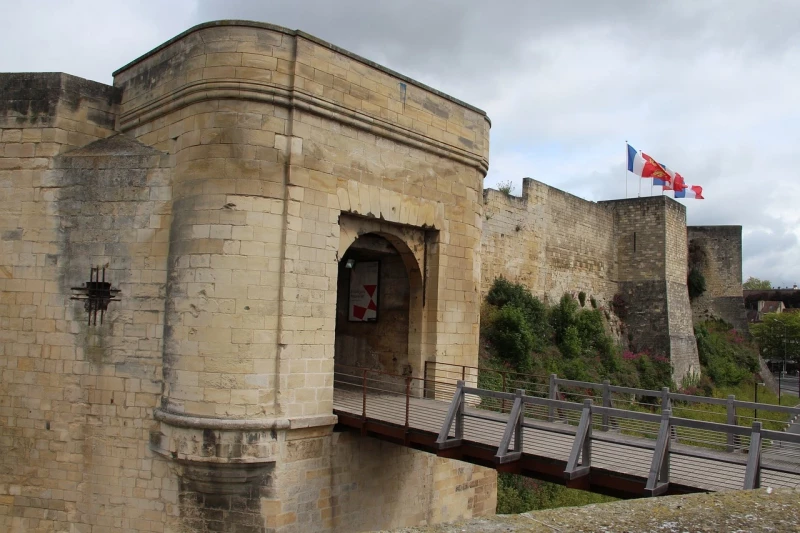
Le Château de Caen, situé au cœur de la ville éponyme en Normandie, incarne une riche histoire qui s'étend sur près de dix siècles. Construit par Guillaume le Conquérant au 11e siècle, ce château imposant a joué un rôle crucial dans la consolidation du pouvoir normand en Angleterre. Ses murs de pierre épais, ses tours imposantes et son donjon témoignent de l'architecture militaire de l'époque. Le château a également été le lieu de résidence de plusieurs ducs de Normandie.
Aujourd'hui, le Château de Caen abrite plusieurs musées, dont le Musée de Normandie, mettant en lumière l'histoire et la culture de la région. Les visiteurs peuvent déambuler à travers les remparts, explorer les salles d'exposition, et profiter de panoramas spectaculaires sur la ville. Le Château est également le site de la magnifique Église Saint-Georges, un exemple remarquable d'architecture romane.
Que ce soit pour son importance historique, son architecture impressionnante ou ses musées enrichissants, le Château de Caen demeure un incontournable, offrant une plongée fascinante dans le passé médiéval de la Normandie.
 Nos astuces pour tirer le meilleur parti de votre expérience.
Nos astuces pour tirer le meilleur parti de votre expérience.
Visiter le Château de Caen est une expérience immersive dans l'histoire médiévale de la Normandie. Voici quelques astuces pour profiter pleinement de votre visite :
-
Billets Combinés : Si vous prévoyez de visiter d'autres sites à Caen, envisagez d'acheter des billets combinés pour économiser sur les coûts d'entrée.
-
Audio-guide ou Visite Guidée : Utilisez un audio-guide ou optez pour une visite guidée pour obtenir des informations détaillées sur l'histoire du château et de ses environs.
-
Horaires d'Ouverture : Vérifiez les horaires d'ouverture du château et planifiez votre visite en conséquence. Certains moments de la journée peuvent être plus calmes.
-
Exploration des Remparts : Prenez le temps d'explorer les remparts du château. Ils offrent une vue panoramique sur la ville de Caen.
-
Musées à l'Intérieur : Explorez les musées à l'intérieur du château, en particulier le Musée de Normandie, pour en apprendre davantage sur l'histoire locale.
-
Église Saint-Georges : Ne manquez pas l'Église Saint-Georges située à l'intérieur du château. Son architecture romane est impressionnante.
-
Expositions Temporaires : Consultez le programme des expositions temporaires qui pourraient avoir lieu dans le château. Elles ajoutent souvent une dimension contemporaine à la visite.
-
Temps de Détente dans les Jardins : Si les jardins du château sont accessibles, profitez d'un moment de détente dans cet environnement historique.
-
Photographie : Capturez les vues panoramiques et les détails architecturaux du château, mais assurez-vous de respecter les règles de photographie du site.
-
Connaissances Préalables : Familiarisez-vous avec l'histoire du château avant votre visite pour mieux apprécier les détails historiques.
-
Événements Spéciaux : Renseignez-vous sur d'éventuels événements spéciaux ou activités organisés au château pendant votre visite.
-
Respect des Lieux : Soyez respectueux des lieux historiques. Évitez de toucher des objets anciens et suivez les indications du personnel.
En suivant ces astuces, votre visite au Château de Caen sera non seulement éducative mais aussi une immersion complète dans le passé médiéval de cette région emblématique de France.
8 - Bayeux
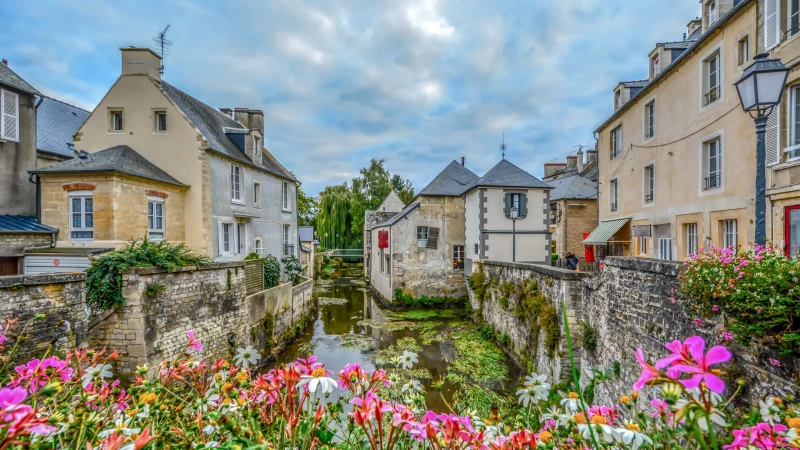
Située en Normandie, la ville de Bayeux enchante les visiteurs avec son riche patrimoine historique et son charme médiéval. Au cœur de la ville se dresse la majestueuse cathédrale Notre-Dame de Bayeux, un chef-d'œuvre de l'architecture gothique qui témoigne de l'élégance et de la grandeur du Moyen Âge. L'attraction principale, cependant, reste la célèbre Tapisserie de Bayeux, un chef-d'œuvre brodé du XIe siècle qui raconte l'épopée de la conquête normande de l'Angleterre.
Les ruelles pavées de Bayeux invitent à une déambulation paisible, révélant des maisons à colombages pittoresques, des boutiques d'artisanat local et des cafés accueillants. La Place Charles de Gaulle, avec son horloge fleurie, offre un lieu central animé pour s'imprégner de l'atmosphère animée de la ville. Les amoureux d'histoire peuvent explorer le Musée de la Bataille de Normandie et le Cimetière Militaire Britannique, commémorant les héros tombés lors du débarquement du Jour J.
Bayeux sert également de point de départ idéal pour explorer les plages du débarquement, marquant un tournant décisif de la Seconde Guerre mondiale. La cuisine normande délectable, mettant en valeur le camembert, le cidre et les fruits de mer, ajoute une touche gastronomique à l'expérience. Bayeux, imprégnée d'histoire et d'authenticité, offre un voyage dans le temps tout en capturant le cœur de la Normandie, entre tradition et modernité.
 Nos astuces pour tirer le meilleur parti de votre expérience.
Nos astuces pour tirer le meilleur parti de votre expérience.
Visiter Bayeux est une expérience riche en histoire et en charme. Voici quelques astuces pour profiter au maximum de votre séjour :
-
La Tapisserie de Bayeux en Premier : Commencez par visiter la célèbre Tapisserie de Bayeux, un trésor historique unique. Cela vous donnera un contexte captivant pour explorer le reste de la ville.
-
Visite Matinale : Optez pour une visite matinale pour éviter les foules et profiter de la tranquillité des rues de Bayeux.
-
Balade dans la Vieille Ville : Explorez la vieille ville à pied, en vous perdant dans les ruelles étroites. Vous découvrirez des boutiques pittoresques, des cafés charmants et des maisons à colombages.
-
Cathédrale Notre-Dame de Bayeux : Ne manquez pas la majestueuse cathédrale Notre-Dame. Grimpez les escaliers pour une vue panoramique sur la ville.
-
Musées : En plus de la Tapisserie, explorez d'autres musées, tels que le Musée de la Bataille de Normandie, pour approfondir votre compréhension de l'histoire locale.
-
Guides Locaux : Si possible, engagez un guide local pour obtenir des informations approfondies sur l'histoire et les anecdotes de Bayeux.
-
Plages du Débarquement : Utilisez Bayeux comme point de départ pour visiter les plages du débarquement. De nombreuses excursions sont disponibles.
-
Dégustation de Produits Locaux : Goûtez aux spécialités normandes dans les restaurants locaux. Le camembert, le cidre et les fruits de mer sont des incontournables.
-
Jardins Publics : Faites une pause dans les jardins publics pour profiter d'un moment de détente au cœur de la ville.
-
Événements Spéciaux : Renseignez-vous sur les événements spéciaux ou festivals qui pourraient avoir lieu pendant votre séjour.
-
Achats Souvenirs : Explorez les boutiques locales pour acheter des souvenirs uniques, comme des produits artisanaux normands.
-
Location de Vélo : Louez un vélo pour explorer les environs de Bayeux, notamment la campagne normande.
En suivant ces astuces, vous aurez l'occasion d'apprécier pleinement l'histoire, la culture et la beauté de Bayeux, faisant de votre visite une expérience inoubliable.
9 - Château de Falaise
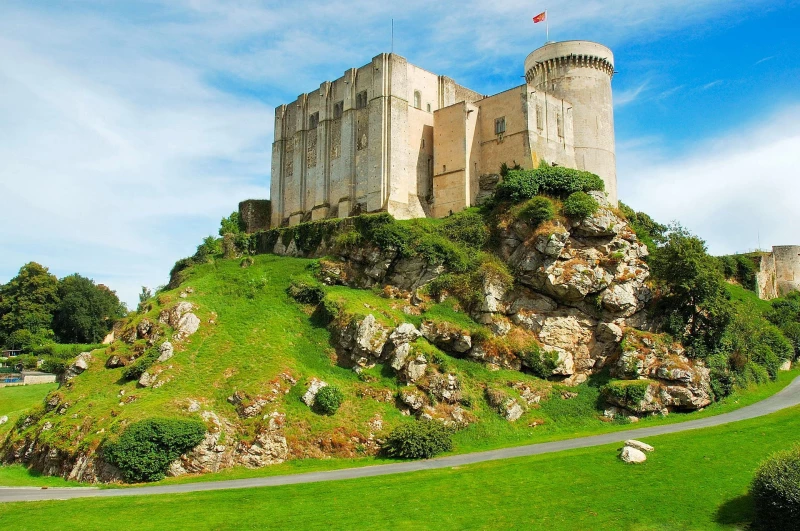
Le Château de Falaise, situé dans la région de Normandie, France, est une forteresse historique qui domine la ville de Falaise. Construit au Xe siècle, ce château a une importance capitale dans l'histoire médiévale normande. Il est particulièrement connu pour être le lieu de naissance de Guillaume le Conquérant en 1027. Le château a été témoin de nombreuses batailles et a subi plusieurs transformations au fil des siècles.
Les visiteurs du Château de Falaise peuvent explorer ses tours imposantes, ses remparts bien préservés, et sa cour intérieure offrant des vues panoramiques sur la ville. L'intérieur du château abrite un musée fascinant présentant l'histoire de la forteresse et de son illustre résident, Guillaume le Conquérant. Des expositions interactives et des artefacts médiévaux ajoutent une dimension immersive à la visite.
La visite du château permet également de se plonger dans l'architecture militaire médiévale et offre un aperçu de la vie quotidienne à cette époque. Les jardins entourant le château ajoutent une touche pittoresque à l'ensemble, offrant un cadre idéal pour une promenade paisible. En résumé, le Château de Falaise est un trésor historique qui allie une architecture impressionnante à une riche histoire, faisant de chaque visite une plongée captivante dans le passé médiéval de la Normandie.
 Nos astuces pour tirer le meilleur parti de votre expérience.
Nos astuces pour tirer le meilleur parti de votre expérience.
Visiter le Château de Falaise est une expérience enrichissante qui offre un aperçu captivant de l'histoire médiévale. Voici quelques astuces pour tirer le meilleur parti de votre visite :
-
Guides et Audioguides : Optez pour un guide local ou utilisez un audioguide pour obtenir des informations détaillées sur l'histoire du château et des anecdotes fascinantes.
-
Horaires d'Ouverture : Vérifiez les horaires d'ouverture du château et planifiez votre visite en conséquence. Certains moments de la journée peuvent être plus calmes.
-
Expositions Temporaires : Renseignez-vous sur d'éventuelles expositions temporaires qui pourraient avoir lieu au château. Elles peuvent ajouter une dimension supplémentaire à votre visite.
-
Jardins et Points de Vue : Explorez les jardins entourant le château pour des vues panoramiques sur la région. Certains points offrent des perspectives uniques.
-
Visite Nocturne : Si disponible, envisagez une visite nocturne pour une expérience différente et pour voir le château illuminé.
-
Photographie : Capturez la beauté du château, mais assurez-vous de respecter les règles de photographie du site.
-
Musée Interactif : Explorez le musée interactif à l'intérieur du château, offrant des expositions innovantes sur l'histoire médiévale et la vie à l'époque.
-
Visite en Famille : Si vous voyagez en famille, vérifiez si des activités spéciales ou des visites guidées adaptées aux enfants sont proposées.
-
Renseignements Préalables : Familiarisez-vous avec l'histoire du château avant la visite pour mieux comprendre les contextes historiques.
-
Événements Spéciaux : Consultez le calendrier des événements spéciaux ou des reconstitutions historiques qui pourraient avoir lieu.
-
Conseils Locaux : N'hésitez pas à demander des conseils aux habitants ou au personnel du château pour des recommandations locales.
En suivant ces astuces, votre visite au Château de Falaise sera non seulement éducative mais aussi une immersion complète dans le passé médiéval de cette forteresse emblématique.
10 - La tapisserie de Bayeux
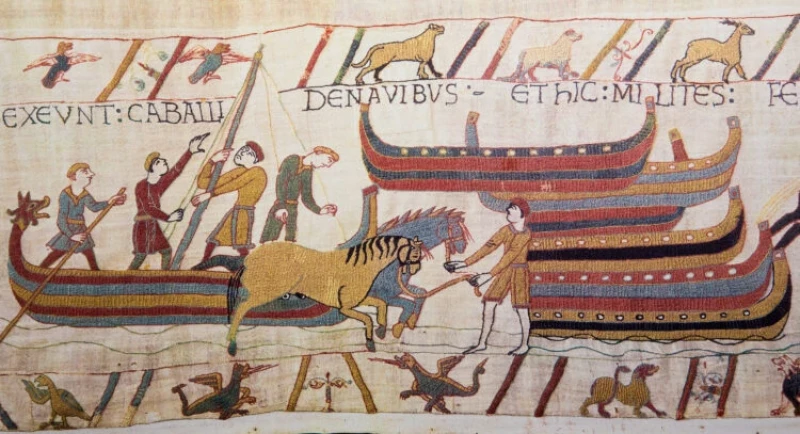
La Tapisserie de Bayeux est une œuvre d'art textile exceptionnelle qui raconte l'histoire de la conquête normande de l'Angleterre en 1066, plus spécifiquement la bataille de Hastings. Elle mesure environ 70 mètres de long et est brodée sur une toile de lin. Cette tapisserie médiévale est un trésor historique unique au monde.
Réalisée au XIe siècle, peu de temps après les événements qu'elle décrit, la Tapisserie de Bayeux est une précieuse source d'informations historiques. Elle détaille la préparation de l'expédition normande, la célèbre bataille avec le roi Harold II d'Angleterre, et la victoire de Guillaume le Conquérant.
La tapisserie est caractérisée par ses scènes vivantes, ses couleurs vives et son style de broderie complexe. Elle est souvent exposée au Musée de la Tapisserie de Bayeux, situé à proximité de la cathédrale Notre-Dame de Bayeux.
La Tapisserie de Bayeux est non seulement un chef-d'œuvre artistique, mais elle offre également un aperçu précieux de l'histoire médiévale. Elle continue de fasciner les visiteurs du monde entier et demeure l'un des trésors culturels les plus importants de la Normandie.
 Nos astuces pour tirer le meilleur parti de votre expérience.
Nos astuces pour tirer le meilleur parti de votre expérience.
Pour profiter pleinement de votre visite à la Tapisserie de Bayeux, voici quelques astuces :
-
Horaire de Visite : Choisissez un moment de la journée où le musée est moins fréquenté pour une expérience plus tranquille.
-
Visite Guidée ou Audioguide : Optez pour une visite guidée ou utilisez un audioguide pour obtenir des informations détaillées sur chaque scène de la tapisserie.
-
Étudiez l'Histoire au Préalable : Familiarisez-vous avec l'histoire de la Tapisserie de Bayeux avant la visite. Cela enrichira votre compréhension des événements qu'elle dépeint.
-
Musée de la Tapisserie : Explorez également les autres sections du musée qui présentent des informations complémentaires sur la broderie médiévale et l'histoire de la région.
-
Respect des Règles du Musée : Suivez attentivement les règles du musée, en particulier en ce qui concerne la photographie et la préservation de l'œuvre.
-
Temps de Visionnage : Prenez le temps d'admirer chaque détail de la tapisserie. Les scènes sont riches en informations et en art.
-
Expositions Temporaires : Renseignez-vous sur d'éventuelles expositions temporaires qui pourraient compléter votre visite.
-
Billets Combinés : Si d'autres sites historiques de Bayeux vous intéressent, vérifiez s'il existe des billets combinés pour économiser sur les coûts d'entrée.
-
Activités pour les Enfants : Si vous voyagez avec des enfants, consultez s'il existe des activités spéciales pour les rendre plus engagés dans la visite.
-
Explorez les Environs : Profitez de votre séjour à Bayeux pour explorer d'autres attractions à proximité, comme la cathédrale Notre-Dame ou le Musée Mémorial de la Bataille de Normandie.
En suivant ces astuces, votre visite à la Tapisserie de Bayeux sera à la fois éducative et mémorable, vous permettant d'apprécier pleinement ce trésor historique exceptionnel.
11 - Découvrez le Château de Fontaine-Henry
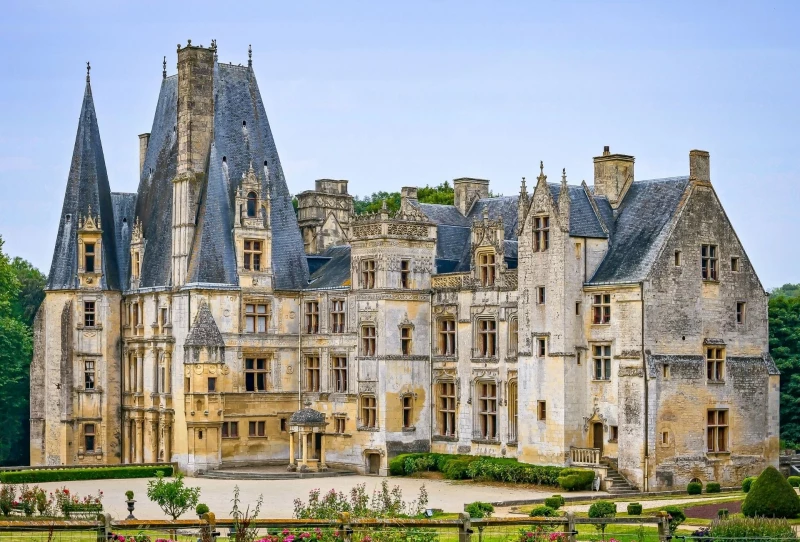
Le Château de Fontaine-Henry, situé dans la campagne normande, est un joyau architectural datant du XVIIe siècle. Ce château classé monument historique offre une expérience immersive dans l'histoire et le charme de la région.
Construit au début du XVIIe siècle, le Château de Fontaine-Henry se caractérise par son style Renaissance et son élégance. Le château est entouré d'un magnifique parc à l'anglaise, créant une atmosphère paisible et pittoresque. Les visiteurs peuvent déambuler dans les jardins soigneusement entretenus, admirer les sculptures, les fontaines et profiter de la quiétude des lieux.
L'intérieur du château révèle des salons richement décorés, des cheminées imposantes et des meubles d'époque, offrant un aperçu de la vie aristocratique du XVIIe siècle. Le Château de Fontaine-Henry abrite également une collection d'art et d'objets anciens.
Pour une visite complète, il est recommandé de vérifier les horaires d'ouverture, de participer à une visite guidée pour en apprendre davantage sur l'histoire du château, et éventuellement de profiter d'événements spéciaux ou d'expositions temporaires qui pourraient avoir lieu.
En somme, le Château de Fontaine-Henry est une escapade idéale pour les amateurs d'histoire, d'architecture et de nature, offrant une expérience authentique au cœur de la Normandie.
 Nos astuces pour tirer le meilleur parti de votre expérience.
Nos astuces pour tirer le meilleur parti de votre expérience.
Pour profiter pleinement de votre visite au Château de Fontaine-Henry, voici quelques astuces :
-
Horaires d'Ouverture : Vérifiez les horaires d'ouverture du château avant votre visite. Cela vous permettra de planifier votre journée de manière optimale.
-
Visite Guidée : Optez pour une visite guidée si elle est disponible. Les guides peuvent fournir des informations fascinantes sur l'histoire, l'architecture et les anecdotes liées au château.
-
Événements Spéciaux : Renseignez-vous sur d'éventuels événements spéciaux ou expositions temporaires qui pourraient avoir lieu au château pendant votre visite.
-
Application ou Audioguide : Si le château propose une application mobile ou un audioguide, utilisez-les pour enrichir votre expérience avec des commentaires détaillés.
-
Explorez les Jardins : Prenez le temps d'explorer les jardins du château. Ils sont souvent magnifiquement entretenus et offrent une atmosphère paisible.
-
Photographie : Consultez les règles du château concernant la photographie. Certains endroits peuvent avoir des restrictions pour protéger les œuvres et l'environnement.
-
Connaissances Préalables : Familiarisez-vous avec l'histoire du château avant votre visite pour mieux apprécier les détails architecturaux et historiques.
-
Billets Combinés : Si d'autres sites historiques se trouvent à proximité, vérifiez s'il existe des billets combinés pour économiser sur les coûts d'entrée.
-
Pause Détente : Prévoyez une pause détente dans les espaces verts du château pour profiter de l'atmosphère sereine.
-
Boutique Souvenirs : Explorez la boutique de souvenirs pour des articles uniques liés au château.
En suivant ces astuces, votre visite au Château de Fontaine-Henry sera une expérience enrichissante, vous permettant d'apprécier pleinement l'histoire et le charme de ce magnifique site historique.
12 - Parcourez la ville de Rouen
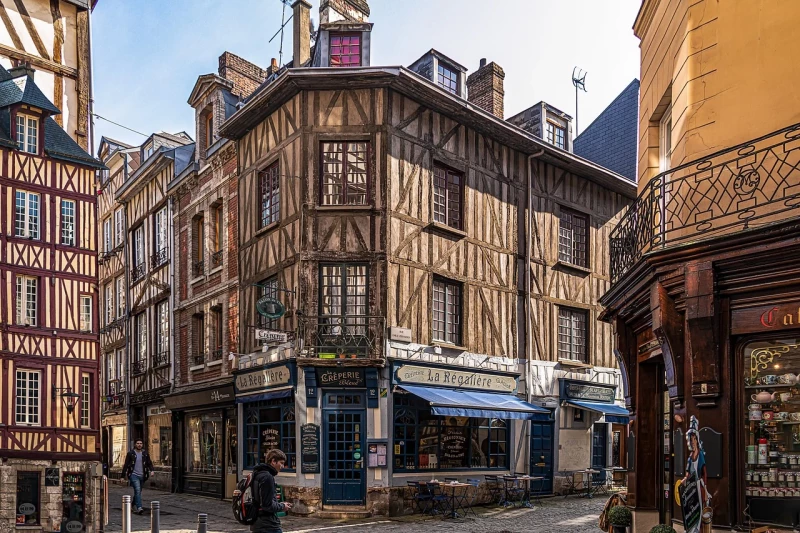
La ville de Rouen, située en Normandie, France, est une destination riche en histoire, en culture et en architecture. Voici quelques points d'intérêt et conseils pour explorer cette charmante ville :
-
La Cathédrale Notre-Dame de Rouen : Commencez votre visite par la célèbre cathédrale. Son architecture gothique impressionnante et ses vitraux magnifiques en font un incontournable.
-
Le Gros-Horloge : Dirigez-vous vers le Gros-Horloge, une horloge astronomique du XIVe siècle située dans une arche Renaissance. C'est l'un des symboles emblématiques de Rouen.
-
Le Vieux Marché : Explorez le Vieux Marché, une place animée entourée de maisons à colombages. C'est également l'endroit où Jeanne d'Arc a été exécutée, et vous y trouverez une église dédiée à sa mémoire.
-
Le Quartier Saint-Maclou : Perdez-vous dans les rues du quartier Saint-Maclou avec ses maisons à colombages pittoresques et son atmosphère médiévale.
-
Le Musée des Beaux-Arts : Si vous êtes passionné par l'art, visitez le musée des Beaux-Arts de Rouen, qui abrite une collection impressionnante de peintures européennes.
-
Les Quais de la Seine : Profitez d'une balade le long des quais de la Seine, où vous pourrez admirer les ponts pittoresques et l'ambiance fluviale.
-
La Rue du Gros-Horloge : Explorez la Rue du Gros-Horloge, une rue piétonne animée avec des boutiques, des cafés et une vue magnifique sur l'horloge.
-
La Tour Jeanne-d'Arc : Montez à la Tour Jeanne-d'Arc pour une vue panoramique sur la ville. Elle offre un panorama exceptionnel sur les toits de Rouen.
-
La Place du Vieux Marché : Revenez à la Place du Vieux Marché en soirée pour profiter de l'atmosphère animée des cafés et des restaurants.
-
Les Églises : En plus de la cathédrale, explorez d'autres églises remarquables comme l'Église Saint-Maclou et l'Église Saint-Ouen.
Rouen offre une combinaison unique de patrimoine historique et d'énergie contemporaine, créant une expérience captivante pour les visiteurs. Profitez de la gastronomie locale dans les cafés et restaurants, et prenez le temps de vous imprégner de l'atmosphère authentique de cette ville normande.
 Nos astuces pour tirer le meilleur parti de votre expérience.
Nos astuces pour tirer le meilleur parti de votre expérience.
Pour une visite enrichissante de la ville de Rouen, voici quelques astuces :
-
Planification Préalable : Avant de partir, planifiez les sites que vous souhaitez visiter à Rouen. Cela vous aidera à maximiser votre temps.
-
Visite Guidée : Si possible, optez pour une visite guidée. Les guides locaux peuvent fournir des informations approfondies et des anecdotes qui enrichissent votre expérience.
-
Carte de la Ville : Obtenez une carte de la ville pour vous repérer plus facilement et découvrir des itinéraires piétonniers.
-
Horaires d'Ouverture : Vérifiez les horaires d'ouverture des principaux sites que vous prévoyez de visiter, en particulier pour la cathédrale et les musées.
-
Transport en Commun : Utilisez les transports en commun pour vous déplacer dans la ville. Rouen dispose d'un réseau de bus efficace.
-
Gastronomie Locale : Profitez des cafés et restaurants locaux pour déguster la gastronomie normande. Essayez des plats comme la tarte Tatin ou le canard à la rouennaise.
-
Événements Locaux : Consultez le calendrier des événements locaux qui pourraient avoir lieu pendant votre visite. Rouen organise régulièrement des festivals, des concerts et des événements culturels.
-
Billets Combinés : Certains sites touristiques proposent des billets combinés, ce qui peut vous faire économiser de l'argent.
-
Joan of Arc Experience : Explorez les sites liés à Jeanne d'Arc, tels que la Place du Vieux Marché et la Tour Jeanne-d'Arc, pour une expérience historique unique.
-
Musées en Soirée : Certains musées ont des horaires d'ouverture étendus en soirée. Profitez-en pour visiter après le coucher du soleil.
-
Marchés Locaux : Faites un tour dans les marchés locaux pour découvrir des produits régionaux et expérimenter l'ambiance locale.
-
Préparation Météo : Assurez-vous de consulter la météo avant votre visite pour vous préparer adéquatement.
En suivant ces astuces, votre exploration de Rouen sera non seulement agréable mais aussi une plongée enrichissante dans l'histoire et la culture de cette belle ville normande.
La Normandie - Où Loger ?
En Normandie, vous trouverez une variété d'options d'hébergement adaptées à différents goûts et budgets. Voici quelques suggestions sur les endroits où vous pourriez envisager de loger en Normandie, en fonction des principales attractions de la région :
-
Le Mont-Saint-Michel : Pour une expérience unique, envisagez de séjourner sur l'île du Mont-Saint-Michel ou dans les environs immédiats. Les hôtels à l'intérieur de l'île offrent souvent une ambiance médiévale et des vues spectaculaires sur la baie.
-
Rouen : Le centre-ville de Rouen propose de nombreux hôtels, du chic au plus abordable. Séjourner près de la cathédrale ou du Vieux Rouen vous permettra de vous immerger dans l'histoire de la ville.
-
Honfleur : Trouvez un charmant hôtel ou une chambre d'hôtes dans le pittoresque port de Honfleur. Les établissements près du Vieux Bassin offrent souvent une atmosphère maritime agréable.
-
Étretat : Pour profiter des falaises et de la mer, recherchez un hébergement à Étretat. Il existe des hôtels et des chambres d'hôtes offrant des vues magnifiques sur les formations rocheuses.
-
Caen : La ville de Caen propose une variété d'options d'hébergement, des hôtels de chaîne aux établissements plus indépendants. Le centre-ville est idéal pour explorer le château de Caen et d'autres attractions.
-
Giverny : Si vous visitez les jardins de Giverny, vous pouvez trouver des chambres d'hôtes et des petits hôtels dans les environs. Certains offrent même des jardins bien entretenus.
-
Plages du Débarquement : Pour explorer les plages du Débarquement, recherchez un hébergement à Bayeux. La ville propose des hôtels historiques et des maisons d'hôtes, et elle est bien située pour visiter les sites liés au D-Day.
-
Côte Fleurie : Pour des vacances balnéaires, la Côte Fleurie avec des villes comme Deauville et Trouville offre des hôtels de luxe, des spas et des établissements en bord de mer.
-
Villages Normands : Pour une expérience plus authentique, envisagez de séjourner dans des villages normands pittoresques. Vous trouverez des gîtes, des maisons d'hôtes et des chambres d'hôtes dans des environnements paisibles.
-
Parc Naturel Régional des Boucles de la Seine : Pour une immersion dans la nature, recherchez des hébergements dans les environs du Parc Naturel Régional des Boucles de la Seine. Des auberges de campagne et des gîtes peuvent être disponibles.
Lors de la réservation, assurez-vous de vérifier les avis en ligne, la proximité des attractions que vous souhaitez visiter, et si possible, la flexibilité des conditions d'annulation. La Normandie offre une grande diversité d'hébergements pour répondre à différents besoins et préférences de voyageurs.
La Normandie - Comment se déplacer ?
Se déplacer en Normandie peut se faire de plusieurs manières en fonction de vos préférences et de vos besoins. Voici quelques options de transport en Normandie :
-
Voiture : La voiture est souvent le moyen le plus pratique pour explorer la Normandie, surtout si vous souhaitez visiter des endroits éloignés ou hors des itinéraires de transport en commun. Les autoroutes et routes principales sont bien entretenues.
-
Train : Le réseau ferroviaire français est bien développé, et il existe des liaisons ferroviaires entre les principales villes normandes, comme Caen, Rouen, et Le Havre. Les trains peuvent également vous amener à Paris en peu de temps.
-
Bus : Des services de bus régionaux et interurbains desservent de nombreuses destinations en Normandie. Cependant, la fréquence des bus peut varier en fonction des zones rurales et des jours de la semaine.
-
Location de Vélo : La Normandie offre de magnifiques paysages, et la location de vélo peut être une excellente option pour explorer les petits villages, les plages, ou les sentiers côtiers.
-
Ferry : Si vous souhaitez visiter les îles normandes comme Jersey ou Guernesey, vous pouvez prendre un ferry depuis des ports tels que Granville, Carteret, ou Ouistreham.
-
Voie Fluviale : La Seine traverse la Normandie, et des croisières fluviales sont une option relaxante pour découvrir la région depuis un autre point de vue.
-
Location de Voiture Électrique : Certains endroits en Normandie offrent la location de voitures électriques, ce qui peut être une option écologique pour explorer la région.
-
Avion : Si vous arrivez de l'étranger, les aéroports de Caen, Rouen, et Deauville sont des options pour votre arrivée. Cependant, la région est bien desservie par des liaisons ferroviaires avec Paris.
-
Covoiturage : Le covoiturage est de plus en plus populaire en France. Vous pouvez envisager de partager un trajet avec d'autres voyageurs pour réduire les coûts et l'impact environnemental.
Avant de planifier votre moyen de transport en Normandie, il est conseillé de vérifier les horaires, les tarifs, et la disponibilité en fonction de votre destination spécifique.
La Normandie - Meilleure période
La Normandie peut être visitée tout au long de l'année, et le choix de la période dépend de vos préférences en termes de météo, d'événements locaux et d'affluence touristique. Voici un aperçu des saisons en Normandie :
-
Printemps (mars à mai) : Le printemps est une période agréable pour visiter la Normandie. Les températures commencent à se réchauffer, les jardins sont en fleurs, et la région prend vie avec une ambiance fraîche et verdoyante.
-
Été (juin à août) : L'été est la haute saison touristique en Normandie. Les températures sont généralement agréables, mais il peut y avoir des périodes de pluie. C'est la période idéale pour profiter des plages, des festivals, et des activités en plein air.
-
Automne (septembre à novembre) : L'automne offre des températures douces et des paysages colorés avec les feuilles changeantes. C'est une période moins fréquentée que l'été, ce qui peut rendre la visite plus paisible.
-
Hiver (décembre à février) : Les températures hivernales en Normandie sont généralement douces, bien que les averses soient plus fréquentes. Si vous appréciez une atmosphère tranquille et souhaitez éviter les foules, l'hiver peut être une bonne option.
Quelques points à considérer lors de la planification de votre visite en Normandie :
-
Événements Locaux : Consultez le calendrier des événements locaux, festivals, et célébrations qui peuvent enrichir votre expérience culturelle.
-
Marées pour le Mont-Saint-Michel : Si vous prévoyez visiter le Mont-Saint-Michel, vérifiez les horaires des marées. La vue sur le Mont-Saint-Michel est différente à marée haute et à marée basse.
-
Plages du Débarquement : Si vous êtes intéressé par l'histoire de la Seconde Guerre mondiale, notez que la période estivale est la plus fréquentée sur les plages du Débarquement.
-
Jardins de Giverny : Si vous souhaitez visiter les jardins de Giverny, la période idéale est le printemps lorsque les fleurs sont en pleine floraison.
En résumé, la Normandie offre quelque chose tout au long de l'année, alors choisissez la période qui correspond le mieux à vos préférences personnelles et à vos intérêts spécifiques.





